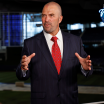Stamkos closing in on 500 goals, 1,000 points in NHL with Lightning
Center's journey to milestones 'been quite a ride'

© Justin Berl/Getty Images
Ahh, the things Stamkos has seen since then.
"Sometimes I have to take a step back and realize 15 years in this League, it's been a quite a ride," Stamkos said earlier this season.
It's a ride that's featured significant twists and turns, huge accomplishments and career-threatening injuries.
But Stamkos has been riding high for a bit now, with two Stanley Cup championships and three consecutive trips to the Final.
And he's about to reach two major individual milestones: 500 goals and 1,000 points in the NHL.
He enters the Lightning game at the Boston Bruins on Tuesday (7 p.m. ET; SNE, SNO, SNP, TVAS, NESN, BSSUN, ESPN+) with 493 goals and 998 points in 943 NHL games.
When he reaches both, he'll be the 45th player in NHL history to do so.
"He's a Hall of Fame player," former Lightning general manager Brian Lawton said. "He's going to be there one day. He's earned it. He's been through hell in a hand basket like a lot of guys that make it to the Hall of Fame. He's had injuries, he's had adversity. But he just found a way to continue to overcome it."
\\*
By the time Stamkos arrived in Toronto for the 2008 NHL Scouting Combine, the blue and white T-shirts, bumper stickers and wrist bands had begun dotting the Tampa area, from parking lots to beaches to the shirts of dancers for the local arena football team, all bearing the same two words.
"Seen Stamkos?"
It was viral marketing before viral was a term. And cemented that the Lightning would select Stamkos with the No. 1 pick in the 2008 NHL Draft.
"It was curiosity," said Oren Koules, a Lightning co-owner at the time. "That's what we were trying to do, get people talking, like, what is this? And that way we got to introduce Steven to the Tampa Bay fans and the whole city.
"It was really pre- the majority of social media. So it wasn't like now where something happens and everyone in the world knows about it in two minutes. It was really more of a local ... I think maybe somebody covered it up in Toronto. Maybe. But it was really a local marketing thing. ... I'm not trying to be like an oldtimer but was just completely different."
Stamkos remembered seeing the clips with amusement.
His future Tampa Bay teammates had a different opinion.
"We just hope he's as good as the hype," Martin St. Louis said earlier this month.
There were some questions if that would happen early in Stamkos' rookie season. Barry Melrose, the Lightning coach that season, didn't think the 18-year-old was NHL ready and didn't give him much ice time. In his first 17 NHL games, Stamkos averaged 12 minutes of ice time.
But those around Stamkos knew he just needed the chance.
"We would see it in practice, the way he shot the puck," said St. Louis, Stamkos' teammate from 2008-14. "I've been around plenty of guys who shoot the puck well in practice and they can never find soft areas to get scoring chances in a game, they don't know where to go on the ice. In practice you have more space and time. 'Stammer' learned quick how to be a goal scorer in the NHL."
That chance came when Rick Tocchet replaced Melrose as coach Nov. 16 of that season. Stamkos' ice time went up (to 15:44 per game) but his production didn't quite match; he had four goals in his first 40 games.
The turning point came when Stamkos was scratched for a game at the Anaheim Ducks on Jan. 9.
"What [Lawton] wanted Steven to do was to see how much space he had, how much time he had," Koules said.
Stamkos, though, took it differently.
TBL at BUF | Stamkos delivers game-winner
"It was something that I used as motivation to show them that I didn't want to sit in the press box anymore, I wanted to play, and that I didn't agree with the decision," he said. "Any time you watch a game for sure you can pick up on some things, you maybe had some more time here and there. But I think at the end, it was more motivation to kind of say, you know, I belong, I don't want to sit here anymore."
Stamkos never sat again. He had a point in his first four games back, had a hat trick against the Chicago Blackhawks on Feb. 17, and finished the season with 32 points (19 goals, 13 assists) in his final 39 games.
The following season, Stamkos emerged as a superstar, tying Sidney Crosby for the NHL lead with 51 goals. At age 20 years, 62 days, he became the fourth-youngest player to score 50 in a season, behind Wayne Gretzky (19 years, 67 days in 1979-80), Jimmy Carson (19 years, 250 days in 1987-88) and Gretzky (20 years, 48 days in 1980-81).
He scored 45 goals in 2010-11, and in 2011-12 he scored 60, at the time the 20th player in NHL history to score at least that many in a season. At age 22 years, 60 days, Stamkos was the third-youngest player to score 60 goals in a season, after Gretzky (21 years, 68 days in 1981-82) and Pavel Bure (22 years, 13 days in 1992-93).
Stamkos then scored 29 goals in the lockout-shortened 48-game season in 2012-13.
In a four-season stretch he won the Rocket Richard Trophy for leading the NHL in goals twice (2009-10, 2011-12) and finished second twice (2010-11, 2012-13). He also had three straight seasons with at least 90 points and played at a 97-point pace in 2012-13 (57 points in 48 games).
"Once he started playing on the power play on that [left] side ... and he started pounding pucks from there, he quickly got an identity," St. Louis said. "That became his spot pretty quick. Once we built the power play around him pulling the trigger, even if he didn't score on the power play or in the game, just the touches he got, the looks that he got, he just built so much confidence and it translated to 5-on-5."
The goal-scoring pace has dropped a bit since his first few seasons in the NHL, but Stamkos has grown in other areas of his game.
Stamkos credits his current and former teammates, including St. Louis and forward Nikita Kucherov, as well as Tocchet and former Lightning assistant coach Adam Oates, for helping him evolve from just a goal scorer to a more complete player.
"You learn lessons through experience in the League and I certainly had a lot of that," Stamkos said. "Marty St. Louis was kind of a huge role model for me, especially in my early years, of how to evolve your game. It can't just stay the same. The guys are too good in this League. You have to find different ways.
"If I look back to where I was at the beginning until now, obviously I'm a much more complete player at both ends of the ice. The attention to detail is something that you don't really think about too much coming in as a kid. You want to score goals and get points, but you realize it's about winning and what you have to do. The playmaking aspect, the defensive aspect, the face-offs, little things like that, that you never really gave a second thought to at the beginning, are very important factors now."
Teammates certainly have seen that growth.
"He's got the tremendous shot, but what he's really improved on I think is just his playmaking abilities," said defenseman Victor Hedman, who joined the Lightning in 2009, one season after Stamkos. "He can shoot, he can make that pass to an open guy. It's not just about the shot anymore. He's a complete player. ... He's probably the best face-off guy on the team. PK he's out there. Big face-offs, 5-on-6 or 5-on-5 late in games, you know he's going to be out there. He's just evolved his game and that's what good players do, they're never satisfied with what they've accomplished. They're always trying to get better and same goes for him."
He's also matured off the ice. Stamkos was named Lightning captain March 6, 2014, about a month after his 24th birthday.
"I think the best part that probably people aren't going to know is how he's grown as our captain, from when he first at a young age became the captain, whether he was ready or not, but how he's really evolved just to be kind of the rock in the [dressing] room and that's the impressive part to me," said Jon Cooper, who has been Lightning coach since 2012-13. "You've watched him go from a kid to a family man, from a sniping Rocket Richard winner to a Stanley Cup champion. It's pretty cool to be a part of."
\\*
The evolution in Stamkos' game is not just from a desire to get better. It's from self-preservation, and lengthening a career that has been short-circuited a few times by serious injuries.
He sustained a broken right tibia during a game against the Boston Bruins on Nov. 11, 2013, had surgery to have a rod inserted and missed four months.
He had surgery in April 2016 to remove a blood clot near his right collarbone which sidelined him for six weeks. He missed the first two rounds of the Stanley Cup Playoffs, returning for Game 7 of the Eastern Conference Final, a 2-1 loss to the Pittsburgh Penguins.
A lower-body injury sidelined him for all but one game during the Lightning's march to the Stanley Cup in 2020. He returned for Game 3 of the Final against the Dallas Stars and scored on his first shot on goal. He played five shifts, totaling 2:47 of ice time, in the series, but teammates lauded his goal, which sparked a 5-2 win and gave the Lightning a 2-1 series lead, as a pivotal moment in their championship run.
But he says the worst injury, and the one that still gives him trouble today, was the torn lateral meniscus in his right knee sustained during a game against the Detroit Red Wings on Nov. 15, 2016. He had surgery and missed the final 65 games of the 2016-17 season.
"That's really been the toughest one to overcome," he said. "That still bugs me the most today. Anytime you have a major surgery like I did, when you put the rod in [the broken tibia], a major surgery on the knee, it's tough. You have to change things up. You change your training style, you change your game. It's about just feeling confident again in your body and you put in the work."
In all, Stamkos has missed 154 regular-season games and 40 playoff games because of injuries.
It's why, when asked about his upcoming milestones, Stamkos said, "Should have been a few years ago if I stayed healthy."
The injuries also led to detractors, and their doubt in him also has provided some needed fuel.
"I've obviously had some really tough injuries and some people have probably written me off after coming back from some of those," Stamkos said. "There's been some extra motivation in that regard for sure. The people who know me the best that have helped me throughout my career know the type of person I am and the work that I put in to come back from some of those injuries in order to get back to playing elite-level hockey, and I'm certainly proud of that. There's been a lot more ups than downs in recent years. And that's what makes it all worth it in the end."
Stamkos doesn't dwell too much on the injuries, nor on the decision he made June 29, 2016, to sign an eight-year contract to remain with the Lightning rather than explore free agency. Stamkos did take time to talk with other teams, including his hometown Toronto Maple Leafs. But he feels now like he did then, that Tampa was the best place for him.
"I don't know how close it really was," Stamkos said. "I met with them obviously, that's no secret. It was really down to probably them and coming back to Tampa. But I said from Day One and I can be totally honest in that I wanted to come back to Tampa and I wanted to make that work."
He re-signed with the Lightning five days after Toronto selected Auston Matthews with the No. 1 pick in the 2016 NHL Draft.
"If you go back and look at where Toronto was at that time, I think they had just maybe drafted Auston Matthews, or they were getting close, so they weren't very good at that time," Stamkos said. "And we had just come off a conference final run and a Stanley Cup Final run before that [in 2015]. I'm probably as loyal a guy as you can get. … I said from the beginning I wanted to stay, and I made sure we did. I wanted to finish the job."
He did finish the job in 2020, and again in 2021, when he was healthy and had 18 points (eight goals, 10 assists) in 23 playoff games.
"It's tough to pick one [favorite Cup win]," Stamkos said. "Pretty amazing story with coming back and scoring that goal in the bubble and everything I kind of overcame. But the second year I was part of every game and had more of an impact. That's the one for me that probably feels … but the first time you lift the Stanley Cup there's no better feeling in the world. They were both amazing."
And Stamkos doesn't feel like he's close to being done. The 32-year-old is second on the Lightning with 26 points (12 goals, 14 assists) in 21 games, and if he stays healthy could become the second player with 1,000 games with the Lightning on April 5 (Vincent Lecavalier, 1,047). He'll turn 33 in February, and his contract runs through the 2023-24 season.
"I will keep playing until my body says no, that's the plan," Stamkos said. "I had a great summer training this summer, feeling good coming in. You get to Year 15 you do start looking down the road a little bit. I mean, playing 20 years would be pretty amazing. So that's five more years, that would probably be the goal right now and then go from there if I'm still feeling great.
"I think I'll always have the passion and love. I think for me with some of the injuries that I've had, it's going to be more of a physical thing than a mental thing to keep going. But as long as I'm feeling as good as I am now, I'd love to keep playing."
In other words, there's still a lot more for Stamkos to see.

















